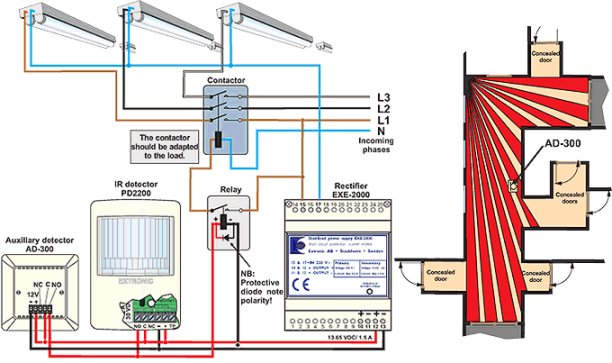2B. Corridor where detection is difficult, with IR detector and acoustic auxiliary detector
50 Hz or non-dimmable HF operating devices
Svenskt patent nr. 9201493-5, English patent No. 0659329
| Premises
With soft floors, angles, screened-off areas and concealed doors in closed premises, a combination of IR detector and AD-300 acoustic auxiliary detector is often the optimum solution, providing maximum comfort. A prerequisite for this solution is for the corridor to be closed, i.e. doors to all other areas must normally be shut. Acoustic detection alone is unsatisfactory because of the soft floor. Light sources This application shows an example of fittings with 50 Hz choke operation or non-dimmable HF operating devices. Control system Unlike with IR technology, the AD-300 acoustic auxiliary detector can activate the lighting before entry into the corridor, creating a very high level of comfort. This facilitates optimisation of tricky corridor solutions where one cannot justify mounting IR detectors all over the place to achieve tolerable detection. The AD-300 is thus a ‘lighting activator’ that complements the IR detector in this example and plan. With entry into the area through a ‘concealed door’ it is to be assumed that the person in question will not stay outside this door for long, but will fairly soon go out into the main passageway, where the IR detector will take over detection. Any effect on the sound detector or IR detector will prolong the time by the period set for the detector in question. Both detectors are coupled to an auxiliary relay against load/contactor to avoid 230 VAC going into the detectors. |
With new buildings or renovations we recommend that dynamic lighting control be installed (see application example with Dynamic lighting control in corridors where detection is difficult!). Detector positioning and choice of lens To achieve optimum detection and a high level of comfort it is important that the IR detector be mounted in the correct place. This is particularly important with corridor solutions. See further in the other application examples for corridors. The optimum direction of detection is when the fields of recognition are crossed at 90°, and the poorest detection is achieved with motion in line with the fields of recognition in either direction. Because of this, a detector using a lens with a 90° opening angle must be selected. It must be mounted in a corner in front of the door so that it is not obscured when the door opens, and must be at the correct height (1.6 – 1.9 m in corridors). With long corridors you can select a lens that has both a long field and a 90° opening angle. For the PD-2200 there are about 40 different lenses to choose from. Correct adjustment is greatly simplified if the BL-1 field-indication diode (Order No. 13035) is used. This especially applies to long corridors. If the fittings have conventional operating devices (choke operation), electronic igniters (e.g. AURA Strike) must be used to reduce wear on the fluorescent tubes. The AD-300 acoustic detector should be positioned centrally. The microphone range can be 20 – 25 m in radius, depending on the acoustic conditions. |
||||||||||||||||||||||||
 |
|||||||||||||||||||||||||

Information for current budget
|
|
||||||||||||||||||||||||





